Here’s a scenario for you: You take care of your aquarium by the book but suddenly there’s a strange black fuzzy growth that’s covering everything.

Scrubbing it removes the stuff for a while but it keeps coming back.
At first, it appears as a black mold, often, in a freshwater aquarium environment and it later develops to a beard-like growth.
It’s progressively attaching itself to plants, decor, and rockwork.
Is it there to stay?
Are black algae in the fish tank bad for aquatic life?
After months of fighting this pest, I really got to know it and finally found the cure.
Or cures.
Let’s cut to the chase here.
What causes Black Beard Algae to appear in fish tanks?
Despite its color, Black algae, also known as Black Beard Algae is a member of the red brush algal family in the Rhodophyta division. There are more than 6000 recognized species of red algae, and what we call “black algae” is one of them.
In fact, in some cases, it can actually appear bluish or greenish in coloration.
These algae are usually introduced to an aquarium from outside sources like contaminated plants or even the guts of fish. This happens through its single-celled spores.
Black algae do not only infest aquariums but also pools, ponds, and other artificially managed bodies of water.
They are very persistent and are often difficult to remove because they have a tendency of returning.
There are three development stages of black beard algae:
- It starts out as tiny black spots covering your aquatic plants or the aquarium’s glass.
- The algae then progress to small patches that look like black fuzzy mold; not uniform. Keep in mind that any true aquatic molds will be white in color and will be a type of fungus. If it’s black – it’s BBA.
- If left unattended, the patches will grow to become very thick and hair-like and will remain soft to the touch (hence the name). They may cover most of your fish tank’s decor.
It’s easy to confuse each stage as a different “type” of black algae but they all are practically the progression of the same thing.
Beware reader: Even though black beard algae isn’t harmful to fish, it can destroy aquarium plants. The algae cover the leaves of the plants which blocks their way of receiving incoming light. Without enough light to create life energy for themselves – the plants could die.

by Ivy_Bells
The truth is you will always get a few BBA spores no matter how careful you are when you pick up new plants or fish. But algal spores won’t be a problem if you don’t allow them to grow and develop.
The two main causes of black algae outbreaks in aquariums are:
- Imbalance of nutrients in the water. Note that I’m saying imbalance and not just “too much”.
Insufficient CO2 in your fish tank is one example.
In that case, your plants simply can’t compete with the algae, because of inefficient photosynthesis processes.
Too much leftover food can result in high phosphate levels which are also favorable to the algae’s growth.
- Improper lighting. Algae takes advantage of the excess light that hits your tank but is not used by your aquatic plants.
Rarely your aquarium’s plant will need over 8 hours of light per day.
However, more often than not, sunlight that’s hitting your tank from a nearby window is often the culprit here. Algae grow like crazy from white daylight but they also really like blue light.
So it’s not a good idea to leave that cool-looking “actinic light” on your aquarium’s LED during night time.
Here are some proper lighting options to consider for a planted tank, that also have customizable spectrums. The link leads to a guide where I give detailed advice on how to approach your aquarium lighting in the correct manner.
Anyway, with the right approach, permanent removal of this type of algae is possible. Algae-eating fish such as the rubber lip pleco, Siamese algae eater, the American flagfish, and the black molly can help immensely.
The issue, however, should be resolved at its core. You don’t really want to rely on algae eaters to manage algae issues.
Here’s what a heavy black beard algae infestation looks like in an aquarium:
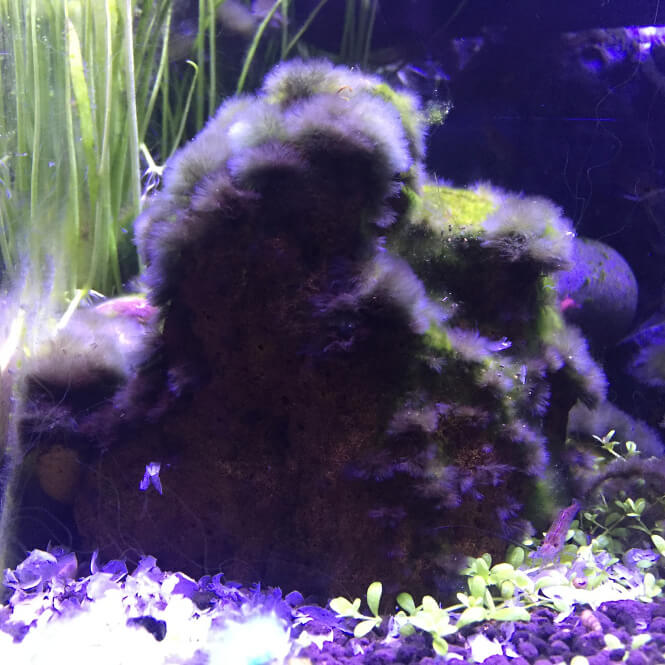
by Grahms
And here’s how black algae appears inside a pool:

How to remove black beard algae from your aquarium once and for all?
Despite being really good at exploiting nutrients, this invader has weaknesses. Even though it took me some time, I did my research and came up with a couple of solutions.
They have all been tested in my or other people’s fish tanks.
I am confident to share them with you.
To get rid of the black beard algae in your aquarium for good you should:
1. Dip all of the affected decor and plants in Hydrogen Peroxide.
A regular over-the-counter peroxide solution of 3% is strong enough to kill black algae.
Peroxide dips are often used for fungi treatment on new plant seeds right before their germination.
Bear in mind that the more gentle live plants in your aquarium like Japanese Moss balls and Anubias may take some damage as well.
For killing the algae on more sensitive plants, I recommend using a 1:3 solution of Hydrogen Peroxide to water. This way the solution will be weaker and spare your plants, but it could take more than one dip to completely rid them of the hair algae.
Anyway, it’s worth taking the risk considering you’ll be removing the nasty black beard algae that are suffocating the plant’s photosynthesis.
If you only have plastic plants you can even use bleach in a 1 to 20 ratio, although peroxide will work too.
Soak all other aquarium decor that is visibly covered in black spots or fuzzy patches for 2 to 3 minutes (use a timer!) and then rinse thoroughly.
The nice thing about peroxide is that it leaves virtually no residue and you can instantly put your plants and rock back in the aquarium. That’s because Hydrogen Peroxide quickly breaks down to oxygen and pure water when exposed to light.
Anyway, I know that soaking in pure peroxide might seem a little radical, but in my experience, this is the best way to remove black algae from any plants or other aquarium decor.
Another less effective but still viable method here would be to spot-dose the peroxide.
That’s done by using a syringe with the solution and squirting some of that right over the affected areas in the tank.
This is done directly in the tank, without removing decor.
However, simply dosing teaspoons of peroxide in your fish tank water won’t cut it for black algae.
Author’s note: Never soak your tank’s substrate. The substrate is where most of the beneficial bacterial colonies live. You want to keep these bacteria alive so that they can keep transforming toxic ammonia into nitrate, which is almost harmless to your pet fish.
2. Reduce phosphate (PO4) in the water.
Phosphates are a byproduct of almost everything that decays in your aquarium.
This includes leftover food when you accidentally overfeed, plant and algae decay, and even fish waste.
However, phosphates will also spike with the use of carbon filter media, hydrogen ion buffer solutions (pH buffers), kH buffer solutions, and aquarium salts.
If these sound like way too many possible causes, know that I haven’t even revealed the main one yet.
Tap water itself.
The local water authorities, however, found a clever way to fight the lead corrosion in the pipes.
Lead poisoning is quite dangerous so they figured that adding some phosphates to the water (which are basically harmless) will prevent said corrosion.
It’s a smart move to test your tap water for PO4, which can be the hidden reason behind your aquarium algae infestation. Unless there are a lot of other aquatic plants in your aquarium to use it up, Black algae thrive in phosphate levels of 1 ppm and above so your testing results need to be rather precise.
One of the more reliable Phosphate testing kits that I would recommend is the one from API, but you can research other brands as well if you have the time.
Anyhow, if you suspect that your tap water is the issue, then you have two options:
- Find another source of water for routine water changes – Distilled or purified water with reverse osmosis (this is a guide I wrote on which one to use) will surely starve your black algae.
If you revert to this solution know that this water needs to be remineralized before adding it to the aquarium.
That’s because water purification removes all minerals – the bad AND the good.
Remineralization adds back the good minerals and the water becomes usable for aquariums again.
Anyhow, a phosphate-free remineralizer I found, that does wonders is Seachem Equilibrium.
- Introducing phosphate absorbing media to your filter – If you end up getting a PO4 absorbing media, make sure that your filter turns the water in your fish tank at least 5 times per hour. A canister filter may be a good option here.
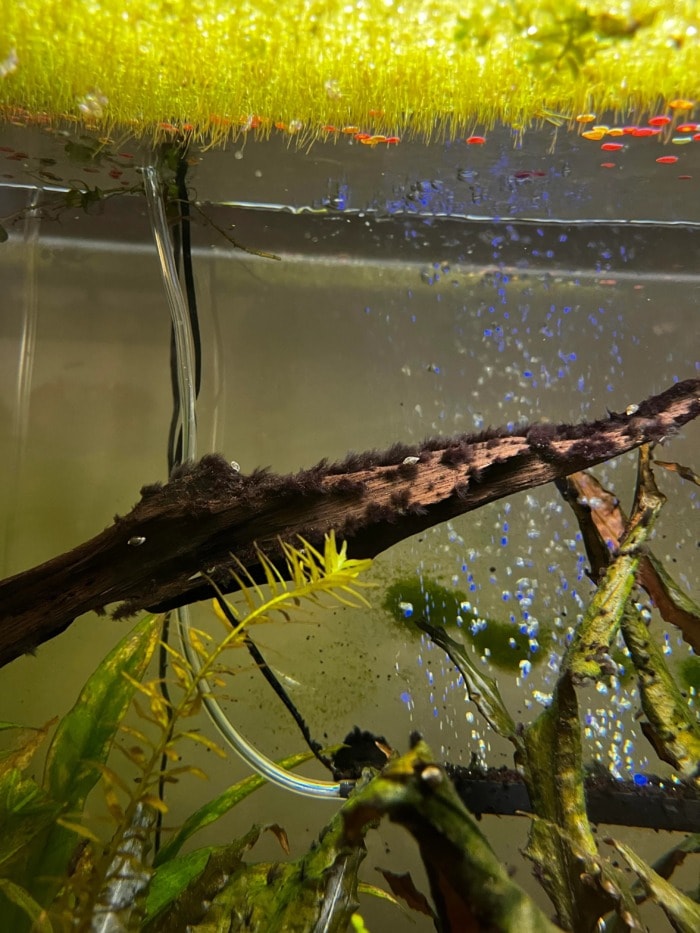
by coralkat
If your aquarium water tests read high PO4 and the tap water shows values below 0.25 ppm (which is considered safe) there are a few ways to lower it by eliminating the causes.
To lower phosphate levels in an aquarium you can:
- Add fast-growing floating aquarium plants – most freshwater floater plants have an enormous hunger for nutrients in the water column of your fish tank. They grow super fast and therefore need a lot of food, which includes Phosphates. I’ve got a quick list of 16 floating aquarium plants that you can check out.
- Replace current fish food – PO4 is used in the making of flake foods, but there are ones containing less phosphate. Elos is a brand that comes to mind as I know for sure that they make efforts in adding as little phosphate as possible.
- Feed your fish sparingly – uneaten food will eventually release phosphate and encourage black algae growth. Dosing meal portions is vital and you should take the number and type of fish you have into account.
- Clean the tank more often – As redundant as it may sound it’s a good idea to go one further on this one. Food and other debris are the usual suspects for phosphate build up in your water.
Always clean filter media with dechlorinated water not to kill any beneficial bacteria that live on it.
- Clean the filter – Filters are known to hold enough muck and residue that will eventually spike the levels of PO4.
- Opt for a carbon media with phosphate absorbers – This is for freshwater fishkeepers. Saltwater carbon filter media is often made in a way that prevents phosphate build-up by default.
- Review your water conditioners – These often have PO4 in them. Everything that treats water from buffers to pH alteration products contains a good amount.
Do yourself a favor and research them well, before buying.
3. Feed your plants by boosting Carbon Dioxide.
Whenever the CO2 levels in your aquarium become low your aquatic plants find it hard to extract the needed amount from the surrounding Hydrogen carbonate.
Black algae, however, is really good at that and it will out-compete your plants and thrive.
When this happens your pH will elevate, which is a really good sign that a poor CO2 level is your problem.
In an aquarium low on carbon dioxide, the algae will be stiffer to the touch and even the Siamese Algae Eaters won’t bother munching on it. By raising the CO2 levels in your aquarium you give your aquatic plants a kickstart to the competition for nutrients and the eventual starvation of the algae.
CO2 is a vital part of the process of photosynthesis and is one component that, when ramped up, actually speeds up the process.
With increased rates of photosynthesis, your aquatic plants will become competitive at sucking up nutrients in the water that would otherwise go to the black algae.
Soon after the effect takes place the BBA will become weak and therefore an attractive snack for your algae eaters, if you have any.
Two stones with one bird, so to speak.
Aside from a gas cylinder and a CO2 regulator with functioning solenoid, there’s another indirect way of allowing your plants to get more Carbon Dioxide in a fish tank. That’s a product called Seachem Flourish Excel.
The active ingredient can be toxic to fish upon continuous use.
It basically works by eliminating the built-up biofilm on plant stems and leaves, which allows them to draw CO2 from the water more efficiently.
If you have fish and invertebrates in the tank, go for half the recommended dose and treat it as a temporary solution.
Just in case.
Also, there’s another algae remover called “No More Black Beard”.
However, this algae remover has a similar active ingredient to Excel, so if you end up getting it, be careful with the dosage as well.
Anyway, back to CO2 injections the classic way, you should aim for 20 to 25 ppm of CO2, granted that your Oxygen levels are in the healthy range.
Don’t forget that carbon may spike your tank’s phosphate, but that’s not an issue when injecting CO2.
The benefits of algae control here significantly outweigh the disadvantages.
4. Introduce black beard algae eaters to your fish tank.
The true Siamese Algae Eaters (SAE for short) are known to feed on black algae.
There’s a catch, though.
Hard, unappetizing algae is a result of low carbon dioxide in planted tanks.
They use the limescale precipitate in a process that hardens their wall cells.
This method should be combined with either the peroxide soak or the CO2 injection method. Both methods will render the algae weak and soft enough for your SAEs to feast on it.
Many people I know report that after weakening the algae a sudden interest from their algae-eating tank pets occurs. That being said, true Siamese Algae Eaters (visit the link for more info on this fish) are not your only friends when it comes to an appetite for algae.
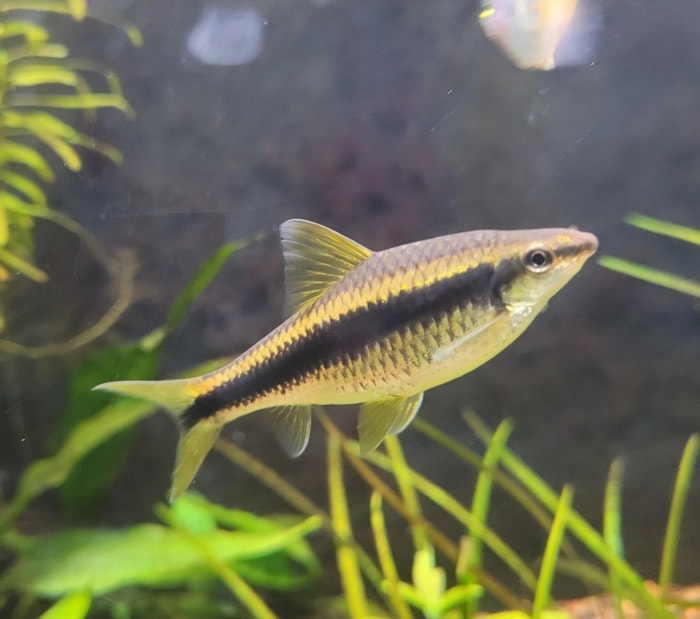
by rtchal
You’ll be surprised at how diverse the reports are on what else eats black beard algae in aquarium habitats.
Most plecos should eat the stuff by definition too, with the rubber lipped ones doing it at impressive rates (link to a complete guide I wrote on those). When the black algae are in their early stages like black spots or small hairy patches even fish with smaller mouths like the Otocinclus would eat them.
Here’s a full list of reported black hair algae eaters:
- American Flagfish – Jordanella floridae;
- Black Molly – Poecilia sphenops;
- True Siamese Algae Eater – Crossocheilus siamensis (young ones, as they pick the habit of feeding on the stuff);
- Chinese Algae Eater – Gyrinocheilus aymonieri (I don’t recommend getting this fish because it becomes too aggressive with age);
- Twig catfish – Sturisoma panamense;
- Bristlenose pleco – Ancistrus spp.;
- Rubber lipped pleco – Chaetostoma formosae;
- Pigmy suckermouth – Otocinclus spp.;
- Rosy Barb – Pethia conchonius;
- Cherry Barb – Puntius titteya;
- Common Goldfish – Carassius auratus;
- Panda Garra – Garra flavatra.
The Amano shrimps are also avid black algae eaters.
Side note: Let me know in the comments if you’ve seen other fish feasting on BBA, so I can expand this list further.
I have written an extensive guide on the best algae eaters in the aquarium-hobby where you can learn more about each of the species listed above.
5. Boil it away with heat treatment.
Algae like warm but not too warm.
Heating up the water is another very effective way of getting rid of the stuff, but you’d need to relocate the inhabitants of your fish tank first.
Find good temporary storage for your fish and live plants.
When I tried this, I left my driftwood and a couple of fake plants in my aquarium as they were all covered in black beard algae.
If it’s just your driftwood that is having algae on it – you can take the piece out of the tank and “boil” it separately.
The whole procedure took me only an hour and a half.
Put your heater at 110 °F to 120 °F (45 °C to 50 °C) and wait it out.
As you can see it’s not literal boiling but just bringing the water to a very high temperature.
I had algae on my live plants as well so after I removed them I dipped them in hydrogen peroxide.
The heat will burn the black algae causing it to eventually die off or get eaten by your algae eaters soon after.
My tips for extra efficiency:
- I would not recommend using water from the fish tank in the temporary one if you’re about to execute the heat method.
Some algae spores might still be present.
The good thing is that the removal will only last a little over an hour, so no cycling and all that is needed.
- While you wait for the water to heat up you can add a couple of spoons of peroxide.
I did a ratio of 1:150 peroxide to water.
Don’t worry, the peroxide dissolves and will not harm your fish afterward with that ratio.
The algae, however, will most likely be permanently destroyed.
- Clean the gravel before the heating.
Get rid of any leftover food or fish waste.
6. Cut out the photosynthesis of the BBA.
This one could be risky if your tank is heavily planted.
Black algae need light but so do your live plants.
This is also the method that was the least efficient for me, but I feel like it’s worth mentioning.
What I did was turn off the lights on my aquarium for 3 days straight.
I made sure no sunlight from the windows could reach the tank too.
After that, I adjusted the daily exposure to light to about 6 hours (instead of the regular 8).
It took the algae more than a week but it did start to disappear.
However, this was not a permanent solution to my problem.
In the rare case where overfeeding your planted aquarium with light is the cause of your BBA issue, it will work for you.
Bear in mind the light needs of your plants – if they are low to medium-light plants then it would probably not damage them.
Prevention of outbreaks – How to never get black algae again

If you got to this part of the article you probably have the answers to that already.
But it’s important to follow this checklist once you’ve defeated the unwelcome invader.
Black beard algae WILL take advantage of any favorable conditions.
To prevent BBA from ever coming back to your aquarium I strongly recommend that you pay attention to:
- Overfeeding – everyone can get carried away with that. I have.
After all, we do care about our pets and want them to feel good, the main part of which is being well-fed.
However, excessive food is also food for algae. Do research on the fish you have and feed them accordingly.
If you’re not confident that you will never overfeed again, I can recommend getting an automatic feeder. Eheim offers one, that’s actually pretty reliable.
If you want to see how the device looks, Amazon has it. There’s also the advantage of not having to worry about feeding when you’re out of town.
- High PO4 levels – You don’t want anything above 0.25 ppm of free Phosphate in your aquarium. If Phosphate is being introduced to your tank in some way you can’t control, there should be enough live plants inside to use it up, instead of the algae.
- Aquarium hygiene – You are probably eye-rolling, as I know everyone is religious when it comes to cleaning. Still, all waste products, even in your filter can cause nutrient imbalance.
- Excessive light – Keep the lights on as much as needed but no more. Investigate your plants’ needs.
- Low CO2 levels – Carbon dioxide is vital for your live plants. With the right levels, they will be able to function properly and effectively use all other nutrients they need.
Healthy plants will outcompete any algae.
- The right equipment – Once you get rid of the intruder you can count on gear to prevent future outbreaks.
Killing algal spores before the bloom occurs is your best bet. Ultraviolet sterilizers use high-energy radiation that damages the DNA of the spores, preventing them from explosively multiplying (visit the link to learn more about that). - Live plants from unknown sources – You could get a plant that carries black algae (though not visibly) even at a big pet store. It’s not paranoid to run them through a light disinfection procedure before adding them to your fish tank.
Use Hydrogen peroxide and water in a 1:4 ratio and let the new plants soak for a couple of minutes.
Better safe than sorry.
- Questionable pet store water – Whenever you buy a new fish, use a net and don’t just pour the water from the bag in your aquarium.
It would be even better if you quarantine the fish for a while before adding them to the tank.I usually wait for 24 hours.
My Conclusion
Black algae is a menace and also one of the most stubborn algae out there.
However, this does not mean we should tolerate it.
And if you take precautionary measures, you’ll never have to deal with it again.
And now I have a question for you.
Did my advice help you?

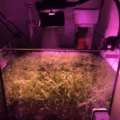
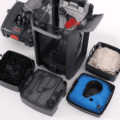





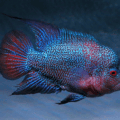
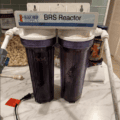

Do you have any suggestions on how to get rid of BBA in well water? We have it so bad until we can’t drink the water and hate to take a bath in it. We live in a rural area and our well is down around 250 feet. No one seems to be able to give us an answer on how to get rid of the BBA that is infesting our well water. Any help would be appreciated; thank you.
Your article is very helpful. I have a black algae in my fish tank on the edges of my plants and on my decorations, but it is crusty, and not hairy. I have not found an article that mentions the Black algae turning hard. I use my tap water and API water conditioner. Do you think this could be my hard water situation in my home? I will try the hydrogen peroxide method. Thanks
Helpful but need more saltwater info. Are there saltwater critters that will help by eating this stuff. Is the peroxide method safe for saltwater fish. Have clown fish.
Hi,
I have a separate article on saltwater algae eaters, look it up in the search bar and check out the species that I’ve listed as “hair” algae eaters.
Peroxide is safe for use in saltwater tanks, but the dosage makes the poison in this case. Micro dosing with a pipette right over the black algae should yield results. Since you mention you have clowns – some anemones might feel a little displeased with the peroxide at first, but ultimately will be fine.
Best,
Momchil
My tank has just developed a very rapid bloom and I’ve never seen this before, so thank you for the tips.
I think I’ve got a few things going on: 1. the fish population exploded, so more waste to water change ratio, 2. I added a new batch of charcoal recently, 3. One of my lights recently broke, so it is dim, 4. I may also be over feeding (probably).
I appreciate your investment to help all of us enthusiasts thrive. Thank you.
Definitely looking forward to trying out these remedies. Thank you for your hard-earned remedial answers to the burning question on so many fish-owners minds.
Thank you for this great info
Thanks for the information. I’ll give it a try.
Thanks for the information on this it was very helpful .